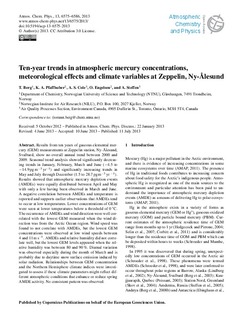| dc.contributor.author | Berg, Torunn | |
| dc.contributor.author | Cole, AS | |
| dc.contributor.author | Engelsen, Ola | |
| dc.contributor.author | Steffen, A | |
| dc.contributor.author | Pfaffhuber, Katrine Aspmo | |
| dc.date.accessioned | 2015-09-30T08:53:08Z | |
| dc.date.accessioned | 2015-11-09T11:51:04Z | |
| dc.date.available | 2015-09-30T08:53:08Z | |
| dc.date.available | 2015-11-09T11:51:04Z | |
| dc.date.issued | 2013 | |
| dc.identifier.citation | Atmospheric Chemistry And Physics 2013, 13(13):6575-6586 | nb_NO |
| dc.identifier.issn | 1680-7324 | |
| dc.identifier.uri | http://hdl.handle.net/11250/2359723 | |
| dc.description.abstract | Results from ten years of gaseous elemental mercury
(GEM) measurements at Zeppelin station, Ny-A° lesund,
Svalbard, show no overall annual trend between 2000 and
2009. Seasonal trend analysis showed significantly decreasing
trends in January, February, March and June (−4.5 to
−14.9 pgm−3 yr−1) and significantly increasing trends in
May and July through December (1.5 to 28.7 pgm−3 yr −1).
Results showed that atmospheric mercury depletion events
(AMDEs) were equally distributed between April and May
with only a few having been observed in March and June.
A negative correlation between AMDEs and temperature is
reported and supports earlier observations that AMDEs tend
to occur at low temperatures. Lower concentrations of GEM
were seen at lower temperatures below a threshold of 0 C.
The occurrence of AMDEs and wind direction were well correlated
with the lowest GEM measured when the wind direction
was from the Arctic Ocean region. Wind speed was
found to not correlate with AMDEs, but the lowest GEM
concentrations were observed at low wind speeds between
4 and 11ms−1. AMDEs and relative humidity did not correlate
well, but the lowest GEM levels appeared when the relative
humidity was between 80 and 90 %. Diurnal variation
was observed especially during the month of March and is
probably due to daytime snow surface emission induced by
solar radiation. Relationships between GEM concentration
and the Northern Hemisphere climate indices were investigated
to assess if these climate parameters might reflect different
atmospheric conditions that enhance or reduce spring
AMDE activity. No consistent pattern was observed. | nb_NO |
| dc.language.iso | eng | nb_NO |
| dc.publisher | European Geosciences Union | nb_NO |
| dc.title | Ten-year trends in atmospheric mercury concentrations, meteorological effects and climate variables at Zeppelin, Ny-Ålesund | nb_NO |
| dc.type | Journal article | nb_NO |
| dc.type | Peer reviewed | en_GB |
| dc.date.updated | 2015-09-30T08:53:08Z | |
| dc.source.pagenumber | 6575–6586 | nb_NO |
| dc.source.volume | 13 | nb_NO |
| dc.source.journal | Atmospheric Chemistry And Physics | nb_NO |
| dc.source.issue | 13 | nb_NO |
| dc.identifier.doi | 10.5194/acp-13-6575-2013 | |
| dc.identifier.cristin | 1054294 | |
| dc.description.localcode | © Author(s) 2013. This work is distributed under the Creative Commons Attribution 3.0 License. | nb_NO |
